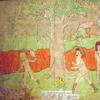Featured 19th Century Painter: Theodore Gegoux (1850 – 1931)
- July 05, 2021 11:22
Theodore Gegoux was French-Canadian who immigrated to Clayton, New York in 1864 to live with his older brother, after the death of his father. As a child he exhibited artistic talent, drawing faces in the margins of his school books. He was severely reprimanded for defacing his books, to the extent that he came to believe that art was bad. After moving to the United States, he took on a number of menial jobs, the last of which was a bartender in the hotel where he stayed. One day in 1873, the proprietor asked young Theo to fetch the local sign painter for a sign he needed, to which he replied, “let me paint your sign”. The sign became the talk of the town and launched Gegoux’s career as an artist. He opened a studio in Carthage, NY., and later, Watertown, N.Y., where he soon received many commissions to paint local notables. His works also included several Civil War generals and Thomas Edison. In addition to his considerable skill as a portraitist, he was also an exceptional landscapist, and without having a formal training, made a good living for himself. By 1881, 19th century artist Theodore Gegoux had saved enough money to travel to Paris for a year of studying and copying the works of the “Great Masters”. In 1896, his portrait, “A Young Paganini”, was accepted for the first Exhibition of the Carnegie Art Galleries. In 1909, Gegoux mysteriously vanished, leaving behind his wife and children.
Call now to talk about your interest in this Theodore Gegoux (1850 – 1931) painting: 724-459-0612 - Jerry Hawk, Bedford Fine Art Gallery


















100x100_c.jpg)
![Peter Paul Rubens (Flemish, 1577–1640), After Titian (Tiziano Vecelli) (Italian [Venetian], c. 1488–1576), Rape of Europa, 1628–29. Oil on canvas, 71 7/8 x 79 3/8 in. Peter Paul Rubens (Flemish, 1577–1640), After Titian (Tiziano Vecelli) (Italian [Venetian], c. 1488–1576), Rape of Europa, 1628–29. Oil on canvas, 71 7/8 x 79 3/8 in.](/images/c/e2/2e/Jan20_Rape_of_Europa100x100_c.jpg)

